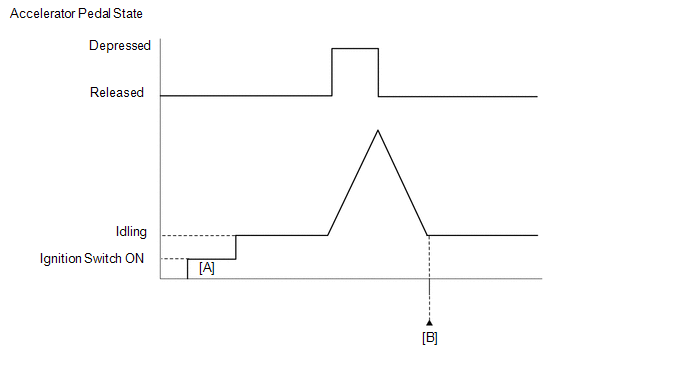DESCRIPTION The throttle actuator is operated by the ECM, and opens and closes the throttle valve using gears. The opening angle of the throttle valve is detected by the Throttle Position (TP) sensor, which is mounted on the throttle with motor body assembly. The TP sensor provides feedback to the ECM so that it can control the throttle actuator (throttle valve) appropriately in response to driver inputs. HINT: This ETCS (Electronic Throttle Control System) does not use a throttle cable.
MONITOR DESCRIPTION The ECM determines that there is a malfunction in the ETCS when the throttle valve remains at a fixed angle despite a high drive current from the ECM. The ECM illuminates the MIL and stores a DTC. If the malfunction is not repaired successfully, a DTC is stored when the accelerator pedal is fully depressed and released quickly (to fully open and close the throttle valve) after the engine is next started. MONITOR STRATEGY
TYPICAL ENABLING CONDITIONS All
TYPICAL MALFUNCTION THRESHOLDS
CONFIRMATION DRIVING PATTERN 
FAIL-SAFE When either of these DTCs or other DTCs relating to ETCS (Electronic Throttle Control System) malfunctions are stored, the ECM enters fail-safe mode. During fail-safe mode, the ECM cuts the current to the throttle actuator and the throttle valve is returned to a 7° throttle angle by the return spring. The ECM then adjusts the engine output by controlling the fuel injection (intermittent fuel-cut) and ignition timing in accordance with the accelerator pedal opening angle to allow the vehicle to continue at a minimal speed. If the accelerator pedal is depressed firmly and gently, the vehicle can be driven slowly. Fail-safe mode continues until a pass condition is detected, and the ignition switch is then turned off. WIRING DIAGRAM Refer to DTC P2102 (See page CAUTION / NOTICE / HINT HINT: Read freeze frame data using the Techstream. Freeze frame data records the engine condition when malfunctions are detected. When troubleshooting, freeze frame data can help determine if the vehicle was moving or stationary, if the engine was warmed up or not, if the air-fuel ratio was lean or rich, and other data from the time the malfunction occurred. PROCEDURE
(a) Connect the Techstream to the DLC3. (b) Turn the ignition switch to ON. (c) Turn the Techstream on. (d) Enter the following menus: Powertrain / Engine and ECT / Trouble Codes. (e) Read DTCs. Result
HINT: If any DTCs other than P2111 or P2112 are output, troubleshoot those DTCs first.
(a) Check for contamination between the throttle valve and housing. If necessary, clean the throttle with motor body assembly. Also, check that the throttle valve moves smoothly. OK: Throttle valve is not contaminated with foreign objects and moves smoothly.
(a) Connect the Techstream to the DLC3. (b) Turn the ignition switch to ON. (c) Turn the Techstream on. (d) Clear DTCs (See page
(e) Turn the ignition switch off and wait for at least 30 seconds. (f) Turn the ignition switch to ON. (g) Enter the following menus: Powertrain / Engine and ECT / Data List / Throttle Position No. 1, Throttle Position No. 2, and Throttle Position Command. (h) Check the values displayed on the Techstream while wiggling the ECM wire harness. (i) Enter the following menus: Powertrain / Engine and ECT / Trouble Codes. (j) Check for DTCs. Result
(a)
As the DTC was stored due to a change in the contact resistance of the
connector, repair or replace the wire harness or connector (See page
(a) Replace the throttle with motor body assembly (See page
HINT: Perform "Inspection After Repair" after replacing the throttle with motor body assembly (See page
(a) Connect the Techstream to the DLC3. (b) Turn the ignition switch to ON. (c) Turn the Techstream on. (d) Clear DTCs (See page
(e) Drive the vehicle in accordance with the driving pattern described in Confirmation Driving Pattern. (f) Enter the following menus: Powertrain / Engine and ECT / Trouble Codes. (g) Read DTCs. Result
|
Toyota Tundra Service Manual > Front Shock Absorber: Installation
INSTALLATION CAUTION / NOTICE / HINT HINT: Use the same procedures for the RH side and LH side. The procedures listed below are for the LH side. A bolt without a torque specification is shown in the standard bolt chart (see page ). PROCEDURE 1. TEMPORARILY INSTALL FRONT SHOCK ABSORBER WITH COIL SPRI ...